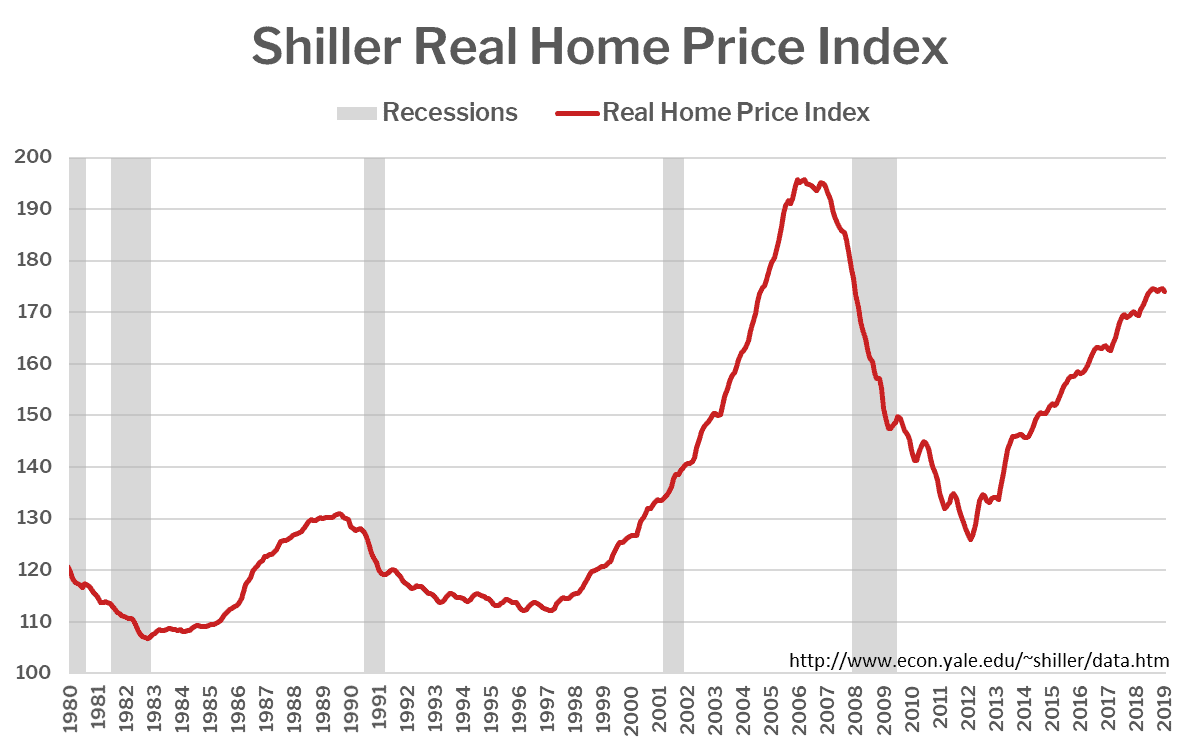Whether it happens this year, next year, or in 10 years, another recession is inevitable. Regardless of when it comes, it’s unlikely to have a large negative impact on the US real estate market. However, there are some metro areas that are more at risk of a housing downturn than others. Riverside, Phoenix and Miami have the highest risk of a housing downturn in the next recession, while Rochester, Buffalo and Hartford have the lowest risk.
With the Great Recession still fresh in Americans’ memories, the idea of a housing crash is psychologically linked with an economic recession for many people today. But historically that usually hasn’t been the case.
Since 1980, there have been five official recessions in the United States. In all but the 2007-2009 Great Recession, inflation-adjusted home prices only declined an average of 2.7 percent from the month before the recession began to the final month of the recession, according to the home price index data from Robert Shiller.

The Great Recession is a major outlier in the relationship between home prices and recessions largely because the overinflated housing market was its major cause. But the housing market, which remains strong, is unlikely to be a culprit or victim of the next recession.
“Home prices are high right now, but they’re high because there’s not enough supply to meet demand, which means there’s not a bubble at risk of bursting,” said Redfin chief economist Daryl Fairweather. “Most of today’s financed homeowners have excellent credit and a cushion of home equity, making them unlikely to default on their mortgage even if their weekly grocery bill grows or their stock portfolio shrinks in the next recession.”
Fairweather continued, “If the U.S. enters a recession in the next two years, it will likely be caused by the global trade war. U.S. industries that rely on exports, like the automotive industry and the agricultural industry, would be the most vulnerable and susceptible to layoffs. Homeowners who are laid off may not be able to continue covering their monthly mortgage payment and may be forced to sell their homes. And would-be homebuyers won’t feel so confident about making a big purchase when they don’t feel confident about their job security or their financial wellbeing. That could cause declines in home prices in markets whose economy depends on global trade, but home prices nationwide are likely to hold steady.”
Whatever does end up causing the next recession, housing markets in certain metro areas are at greater risk of negative impacts like declining prices and a glut of homes for sale. To identify the local housing markets most likely to feel adverse effects from the next recession, we looked at the following factors:
For each metro area, we came up with an overall risk score based on the average of the risk percentiles each weighted factor falls into relative to the 49 other metros.
The metro area with the highest risk of a real estate dip during a recession is Riverside, California, with an overall score of 72.8 percent, followed by Phoenix (69.8%) and Miami (69.5%). The areas at most risk are many of the same regions where housing was hit hardest by the Great Recession, clustered in Southern California, the southwest, and Florida. These are all areas where home prices tend to be more volatile than other parts of the country.This is likely due to their relatively high loan-to-value ratios, and larger share of the market that is dominated by home flippers. These markets tend to attract a lot of investor activity, which can drive prices up, leading local homeowners to take on more debt to afford homes in their area.
The metro area that stands out the most in the top 10 as unusual is Providence at number five. Providence was in the top 80th percentile or higher in four of the seven risk categories: Average Home Loan-to-Value Ratio, Home Price Volatility, Exports Share of GDP and the Share of Households 65+.
Even if a housing downturn does hit these areas with the largest risk, not every home will be affected equally. We found a few factors common among homes that held their value best during the last recession when we investigated that in April, such as large, old homes held their value better than others.
† Loan data not available in all metros. For metros missing this data, the 50th percentile value of 65.4% was assumed when calculating the overall score.
The metro area with the lowest risk of a real estate dip during a recession is Rochester, New York, with an overall score of 30.4 percent, followed by nearby Buffalo (31.9%) and Hartford, Connecticut (33.9%). The areas with the least risk are heavily clustered in the Northeast and the Midwest. This is due to a number of factors, including more affordable home prices, less investor activity, and local economies that are less prone to volatile boom-bust swings.
Not a single metro area among the top 10 with the lowest risk of a housing downturn is west of the Mississippi, unless you count Minneapolis at #10, which straddles the river. The lowest score in the West was Denver, with an overall risk score of 41.5 percent (#12 on the list). The sole metro on the West Coast with a risk score below 50 percent is San Francisco at 42.9 percent, which already began to slow earlier this year and therefore has less risk of a price downturn when the next recession hits.
† Loan data not available in all metros. For metros missing this data, the 50th percentile value of 65.4% was assumed when calculating the overall score.
Below is the full table with the rankings for each of the four recession risk factors for each of the top 50 largest metro areas in the US.
† Loan data not available in all metros. For metros missing this data, the 50th percentile value of 65.4% was assumed when calculating the overall score.


